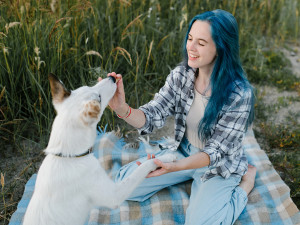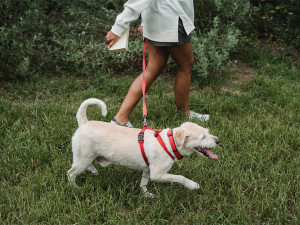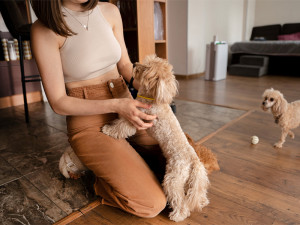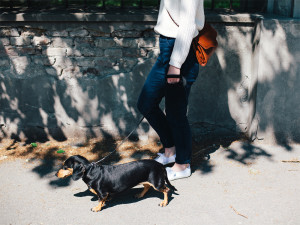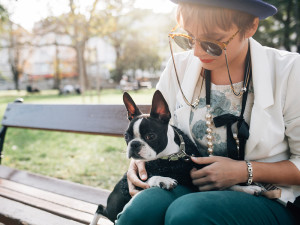How to Potty Train a New Puppy
Tips you’ll want to pay attention to.
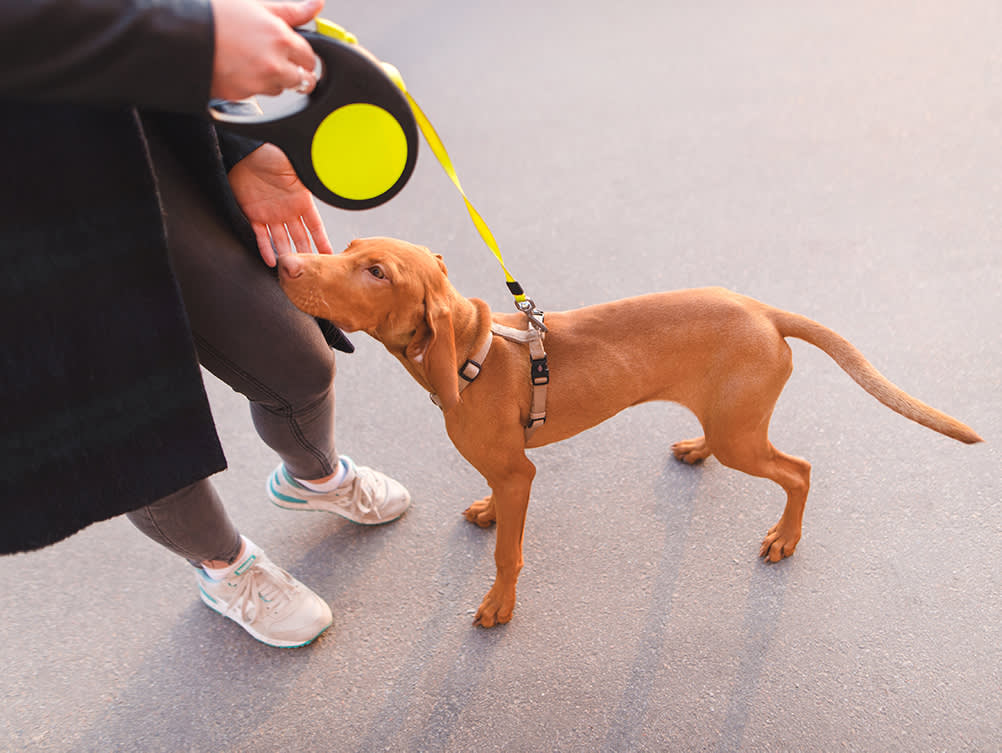
Share Article
In This Article:
Create a Consistent Training Environment Create a Potty Training Schedule Use Positive Reinforcement Advanced Bell Training How to Handle Accidents Common Potty Training Challenges Frequently Asked Questions
If you’ve been planning on adopting a new dog and are doing your homework, you’ve likely read lots on how to care for a new puppy, what kinds of supplies you may need, and the importance of potty training. What the blogs and books don’t always tell you is that potty training is hard, it can feel frustrating, and every dog will take a different amount of time to get the hang of the routine. But fear not: if you can get into the right headspace and accept that setbacks and accidents are all part of the journey, you can approach potty training with confidence.
Potty training is all about that consistency, patience, and positive reinforcement. Just when you think your pup may never figure it out, one day it all clicks and you realize that all your efforts have paid off. The keys to that consistency and reinforcement include establishing a set feeding and bathroom schedule, using a consistent cue (like “potty”), and immediately praising or giving a treat when they pee or poop outside.
You’ve got this! Just be sure to breathe and keep your eye on the big picture. Read on to learn lots of helpful tips and tricks for potty training a puppy.

Create a consistent training environment
It cannot be overstated how important consistency is during potty training. The repetition of the same routine, familiar sites, and cues over and over again helps your pup connect the dots and learn. For this to be effective, everyone must follow the same routine, cues, and schedule. Be sure to communicate with your family, dog walkers and any other caretakers what your plan is so that everyone follows along. Some factors that should be part of your training plan include:
Designate a potty area.
Select a spot that you will use for potty training and use that spot every time. Staying in one spot takes away the novelty of new sites and smells that may distract your pup from the task at hand. Over time, the spot will also retain some smells from their previous pee and poops, too, which can serve as a reminder to them as well.
Establish a verbal cue.
Pick a cue that you will use to associate with potty time for your pup. It can be anything as long as it is a simple, one-word cue that everyone will use, every time.
Limit access within the home.
Whenever you are indoors with your pup, limit the space they can access to avoid accidents in the most undesirable areas. This is most important if your pup is unsupervised; consider creating a puppy pen or other confined area to use in these cases or keep your puppy on a leash and in sight.
Stock up on potty training supplies
Preparation is key. Be sure you have everything on-hand that you need for potty training. Also be sure you have the supplies with you whenever you are taking your pup outside.
Treats and rewards: You need to celebrate each successful potty big time to help your pup make the connection between peeing and pooping in their designated spot and getting a big reward. Figure out what motivates your pup most; a special treat, praise, or a toy can all work for different dogs.
Create a “go bag”: Set up your bag with treats or other rewards, plenty of poop bags, and a leash so that it’s always ready to go by the door.
Enzymatic cleaners and stain removers: Accidents will definitely happen so prepare the best supplies to clean your specific furniture, rugs, or floors. Enzymatic cleaners that actually break down the odors are important to prevent pups from returning to the same location repeatedly to pee or poop.
Puppy pads: These are highly absorbent and make clean up easy; they can be used in your dog’s puppy pen to protect the floor while they are still learning. Some people also train their dogs to pee and poop on the puppy pads as a short-term or long-term solution.
Crate or playpen: Create a safe, puppy-proof space for your dog that can be used when they are unsupervised as well as times when they may need or want to be alone. Training your dog to feel comfortable with these forms of confinement is very important and should be a positive experience for them.
Create a potty training schedule
Puppies need to know when to expect a bathroom break and planning frequent breaks sets them up for success so they never have to hold it beyond what is age-appropriate.
The size and age of your puppy will affect how often they need to go out, as well as the amount of food or water your puppy has recently consumed. Has your puppy just woken up, played, or eaten? Go right outside. In the first few days of potty training, you’re hoping to get lucky by taking them outside at just the right moment.
For your puppy, it will feel like a coincidence at first that they peed or pooped while outside, but the more often you catch those coincidences and reward them, the more they will connect the dots. General guidelines based on age include (note that maximum hold time applies to dogs who are home alone, and maximum is the operable word here):
Two to three months old: Take them out every 30 to 60 minutes, depending on what other activities are going on such as meal times and naps; maximum hold time: three to four hours
Four months old: Take them out every one to two hours; maximum hold time: five hours
Five months: Take them out every two hours; maximum hold time: six hours
Six to nine months: Take them out every two to three hours, depending on feeding and nap times; maximum hold time: no longer than six hours
Adult dogs: Take them out every two to three hours while potty training. They are not accustomed to holding their pee or poop. Most potty-trained adult dogs should go out every four hours, but many can hold their urine for up to eight hours if necessary.
Key timing for bathroom trips
These are automatic triggers for a trip outside as they often coincide with the urge to pee or poop. It can help to carry them straight outside at these times to avoid any chance for them to have an accident on the way:
As soon as they wake up
Post-meals
After playtime
Before bedtime
Note your puppy’s bathroom signals
Over time, you will start to notice the signs that your pup has to pee or poop. Any time you notice the following, take them right outside:
Sniffing the floor
Whining
Circling
Hiding or sneaking off out of view
Positive reinforcement techniques
Positive reinforcement is the idea of rewarding the behaviors you want from your pup so they learn to create a good association between that behavior and the reward. This is the opposite of training techniques that use punishment.
Punishment involves applying a negative association to something you do not want your dog to do; this could be yelling or scolding, physical punishments, or isolating or confining your dog after they do something wrong. These forms of training are never recommended. They induce fear and stress in dogs, which can interfere with their ability to learn. Punishment can have long-term effects on their behavior, bond with humans, and trust in you as well.
Positive-reinforcement training, however, is highly effective, especially when you tailor it to use the rewards that are most high-value to your pup. It makes training fun and strengthens the bond between dogs and their humans. This includes:
Motivating with treats
Figure out what treat is most valuable to your pup. You’ll want to save their favorite foods just for training sessions, and only make them available as a reward for potty training.
Giving verbal praise
Many dogs also respond well to verbal praise and can also be clicker-trained to associate their behaviors with rewards.
Toys and other high-value items
Other dogs may respond best to a special toy or other high-value reward like petting. Whatever is most valuable to your pup is best to motivate them.
Make the connection
For a dog to connect their behavior with a specific reward, the payout has to be nearly immediate. Aim to reward your pup as soon as they potty in the designated spot or within thirty seconds. If there is a longer delay between the action and the reward, it can be difficult for dogs to make the connection.
Advanced bell training
Finding a way for your dog to communicate to you that they need to potty is extremely helpful. Some dogs may naturally find a way to communicate by sitting by the door, barking at you, or grabbing their leash. You can also teach your puppy to ring a bell when they need to pee or poop.
Choose a bell that your dog can either nudge with their nose or swat with their paw. It should be easy for them to reach and make a clear sound with minimal manipulation. Sleigh bell styles that can be hung right next to the door at your dog’s height are a good example. To teach your pup to use the bells, follow these guidelines:
Introduce the bell.
New things can be scary to a puppy, so let them sniff and explore it (don’t let them play tug with it). Once you have your puppy engaging with the bell, you can reward them with a treat each time they touch the bell.
Reward ringing behavior.
Once your puppy is willingly touching the bell, you will transition to rewarding them when they nudge it hard enough to make a sound. Hang the bell in its desired location near the door and start to combine your cues for potty with rewarding your dog for ringing the bell. Then immediately open the door and take them out for their potty break.
Associate outdoor trips.
Whenever you take your dog out for a potty break, use your verbal cue to let them know it’s potty time and reward them if they ring the bell. At first, you can ring the bell to strengthen their association with the sound and potty time. Anytime your dog rings the bell, be sure to reinforce the behavior by taking them out for a brief potty break.
Puppies are very smart, so you’ll want to make sure you are training your puppy to ring the bell only to go to the bathroom and not to go outside and play. Keep the potty trips short and intentionally boring, and save play time for other outings.
How to handle accidents
You can guarantee that accidents will happen during potty training. Think of it as part of the learning process for both you and your puppy and not a failure of any kind. It is important to handle accidents calmly to avoid setbacks in potty training. Some important points to keep in mind include:
Avoid negative punishments.
Resist the urge to scold or punish your dog for having an accident.
Why punishment doesn’t work: This can lead dogs to associate peeing or pooping with fear and anxiety, and they may be more likely to try to use the bathroom in secret. This can lead to more accidents, because they may hide their signals that they need to go, leading to missed opportunities to take them outside and strengthen that association.
Redirecting vs. scolding: Instead of scolding your pup and scaring them if they are caught in the act, try to calmly and quietly pick them up and take them to their potty spot to reinforce the connection. If you can’t catch them in time to redirect them outside, quietly clean up the mess and move on.
Build trust: Punishments, like scolding or sticking a dog’s nose in their mess, create fear and anxiety for dogs. This erodes their trust in their humans and can make them avoidant and more fearful in general, leading to additional behavioral problems. Instead, by rewarding your pup for the behaviors you do want, you can create positive associations. This builds trust and confidence and strengthens the bond between dogs and humans, all while effectively training them.
Eliminate odors to prevent recurrence
Enzymatic cleaners are the most effective at completely eliminating the odor of urine and poop after an accident. Dog’s noses are much more sensitive than ours, and if they can still pick up the scent, they are more likely to return to that spot in the future. Other pets in the home may also start peeing or pooping in that spot if they can smell urine or poop there.
Common potty training challenges
It’s common to run into hiccups throughout the potty training process. A few challenges that pet parents often encounter are:
Nighttime training
You’ll need to give extra consideration to how you’ll manage overnights during potty training. Young puppies won’t be able to hold their urine all night, so you’ll have to have a backup plan for them. This can be a confined area, like a crate or pen with puppy pads.
As they get used to only peeing and pooping outside, they may cry to be let out if they have to pee. If you can take them out for a quick potty stop overnight, you may be able to reinforce their training and avoid a messy cleanup in the morning.
Apartment living
If you have to wait for an elevator or climb multiple flights of stairs to get outside, it can make potty training a bit more challenging. Your pup may have more accidents at first when they have to go urgently and can’t wait to get all the way outside.
For smaller dogs, you may want to consider puppy pad training them first or using a product like puppy potty grass to avoid frequent trips outside. Once they are trained to use their spot indoors and old enough to hold their pee a bit longer, you can work on training them to go outdoors.
Inconsistent progress
If you feel like your pup is starting to get the hang of potty training only to backslide and start having accidents again, you’re not alone. There can be lots of reasons for inconsistent progress, including medical problems, changes in their routine, or certain developmental leaps. Stick with a consistent approach and predictable schedule.
If you feel like you can’t get back on track, be sure to speak with a vet to rule out a medical problem. A behaviorist can also help you trouble-shoot any training challenges once medical issues are ruled out.
Medical considerations
Medical conditions can also add challenges to potty training. This can include problems that cause more urgent, frequent peeing and pooping such as diarrhea, digestive problems, urinary tract infections (UTIs), or other conditions that cause frequent urination.
Progress can also be affected by medical conditions that are not directly related to peeing and pooping including injuries, fevers, congenital problems and more. Any condition that causes pain, or affects their energy levels, appetite, and behavior can interfere with learning and may make it more difficult for them to hold their pee and poop. Be sure to see a vet for any medical problems that arise and expect that you may need to put potty training on hold until they are feeling better.
Bottom line
Potty training can take a while for some dogs so it is important to approach it with an organized plan and lots of patience.
Consistency is the key; this means sticking to a reliable schedule, using specific cues, and lots of positive reinforcement to help your dog understand what you want them to do.
Be prepared for setbacks and see a vet if you are concerned there may be a medical condition interfering with your dog’s potty training.
FAQs
How long does it take to house train a puppy?
All puppies are different, so it’s hard to provide an exact timeline. Your consistency also plays a huge factor in how fast your puppy learns. Younger puppies may need more time, especially because they physically can’t hold their urine for long stretches. With consistent training, it can take between four to six months for your puppy to be potty trained, but some puppies may take longer.
How do you train a puppy with a puppy pad?
Use the same general guidelines for outdoor potty training but the designated spot for them to urinate and defecate will be the puppy pad instead of an outdoor spot. Place your puppy on a pee pad routinely according to the schedule above. You may want to put their leash on each time to serve as a cue that it’s potty time and to help them stay in place on the pad. Reward them for using the bathroom on the pee pad.
How long can puppies hold their pee?
Puppies can generally hold their pee for the number of months they are old plus or minus one. So, a four month old puppy can typically hold their pee for about three to five hours. You should always take a puppy right out to the bathroom after they have just woken up, played, or eaten, even if less time has elapsed, as these activities often trigger the urge.
Do some puppies have a tell before going to the bathroom?
Yes, it’s important to learn your puppies “tells” when potty training. Look out for what your puppy does right before peeing or pooping and if you see those signs, take them right to their potty spot. They may walk around in a circle, sniff the floor, start barking, or become restless.
References
Calder, Christine. “5 Steps to Successfully Housetrain Your Puppy or Adult Dogopens in new tab.” Veterinary Partner. 23 April 2024.
Rooney, Nicola, et al. “Training methods and owner–dog interactions: Links with dog behaviour and learning abilityopens in new tab.” Applied Animal Behavior Science, vol. 132, no. 3-4, July 2011, pp: 169-177.
Vieira de Castro, Ana Catarina, et al. “Improving dog training methods: Efficacy and efficiency of reward and mixed training methodsopens in new tab.” PloS one, vol. 16, no. 2, 19 February 2012, e0247321.

Dr. Amy Fox, DVM
Amy Fox, DVM is a small animal veterinarian in New York City with over thirteen years of experience in a mixture of general practice, emergency medicine, and shelter medicine. A lifelong animal lover, Dr. Fox studied biology in college and then worked as a veterinary nurse before pursuing veterinary school at Cornell University. Her expertise includes surgery, dentistry, and management of chronic conditions, and she is interested in toxicology, pain management, nutrition, care of senior pets, and educational outreach. Dr. Fox also enjoys writing about veterinary medicine and teaching, and her work has previously appeared in Spruce Pets. In her free time, she loves to cook, garden, go for long runs, and hang out with her goofy mixed-breed dog May, who provides never ending comic relief!
Related articles
![puppy jumping up on crate]()
Gimme Shelter: The Best Dog Crates
Spend less time searching for your dog’s house than you do on Zillow.
![girl with blue hair starting puppy training with white dog]()
Puppy Training 101: How to Train a Puppy
You gotta start somewhere.
![A woman with a book in her hand walking her dog on a leash in a grassy park.]()
Why You Should Take Your Pup on a “Scent Walk”—All the Dogs Are Doing It
Why you should let your dog get all their sniffs out on a stroll.
![A woman sitting on a floor playing with her dogs.]()
How to Know if Your Dog Has Imprinted on You
If they’re following you around like your shadow, there’s a reason for that.
![Woman walking her small black dog outside on leash.]()
Do Small Dogs Pee More Often?
Research shows that little dogs may feel the need to scent mark more frequently than big dogs.
![Stylish woman sitting on a bench with her Boston Terrier dog.]()
Here’s Why Your Dog Is Terrified of New People
And how to change this.




